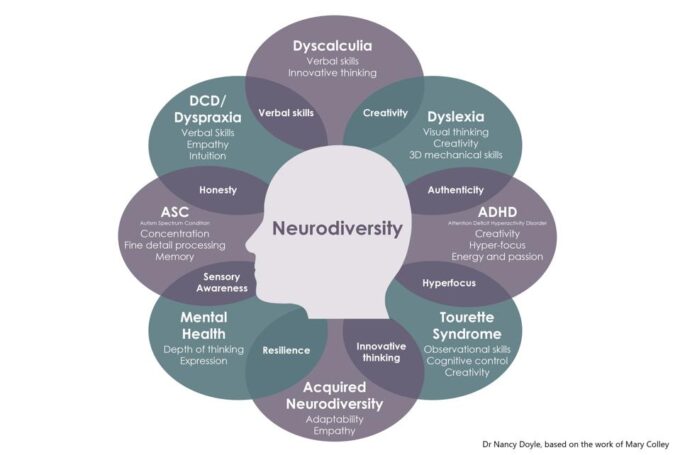Inclusive classroom design to support neurodiversity is increasingly important in K-12 education. This article explores what neurodivergence is, why it’s vital to address it in classrooms, and the latest trends architects use to support neurodivergent students and multi-sensory teaching methods.
Understanding Neurodivergence
Neurodivergence refers to the variation in human brain function and behavior, often encompassing conditions like autism, ADHD, dyslexia, and others. These variations affect how individuals learn and interact with their environment.
Importance of Addressing Neurodivergence in Classrooms
Addressing neurodivergence in the classroom ensures that all students can access education tailored to their unique needs. In addition, it promotes inclusivity, reduces stress, and enhances learning outcomes.
Leading Trends in Neurodivergent Design
Architects are incorporating several key design elements to create neurodivergent-friendly classrooms.
1. Flexible Learning Spaces:
Firstly, flexible spaces allow for reconfiguration to suit various activities and learning styles.
- Example: For example, movable furniture can create quiet zones or collaborative areas as needed.
- Benefit: Supports individualized learning and reduces sensory overload.
2. Sensory-Friendly Environments:
Secondly, designing with sensory needs in mind helps create comfortable and productive spaces.
- Example: Using sound-absorbing materials to reduce noise.
- Benefit: Minimizes distractions and helps students focus.
3. Natural Lighting:
Next, natural light positively impacts mood and concentration.
- Example: Large windows and skylights to maximize natural light.
- Benefit: Reduces reliance on harsh artificial lighting, which can be overstimulating.
4. Color and Texture:
Furthermore, thoughtful use of color and texture can create a calming environment.
- Example: Soft, muted colors and varied textures in furniture and finishes.
- Benefit: Creates a visually soothing space that reduces anxiety.
5. Multi-Sensory Learning Tools:
Finally, designing classrooms to accommodate multi-sensory teaching methods supports diverse learning needs.
- Example: Incorporating interactive whiteboards, tactile materials, and visual aids.
- Benefit: Engages different senses, enhancing learning and retention.
Supporting Teachers with Neurodivergent Design
Classroom design can significantly aid teachers in using multi-sensory methods effectively.
1. Versatile Layouts:
First, layouts that can be easily adjusted support various teaching methods.
- Example: Desks on wheels that can be grouped or separated.
- Benefit: Facilitates quick changes between individual and group activities.
2. Access to Resources:
In addition, designs that provide easy access to educational resources support diverse teaching strategies.
- Example: For example, storage solutions that keep materials organized and accessible.
- Benefit: Enables smooth transitions between different activities and methods.
3. Technology Integration:
Finally, integrating technology seamlessly into classroom design supports interactive and engaging teaching.
- Example: Built-in charging stations for tablets and laptops.
- Benefit: Ensures technology is readily available for interactive learning.
Conclusion
In conclusion, neurodivergent design in K-12 education is crucial for creating inclusive, supportive learning environments. Accordingly, by incorporating flexible spaces, sensory-friendly elements, natural lighting, thoughtful color and texture, and multi-sensory tools, architects can design classrooms that cater to diverse needs. Additionally, these design elements support teachers in employing effective multi-sensory methods, enhancing educational outcomes for all students.
By understanding and implementing these trends, schools can create environments that foster success and well-being for neurodivergent students. Therefore, reach out to our team of experts at EVstudio to include neurodivergent design in your next project.
References:
- American Institute of Architects. “Designing for Neurodiversity in K-12 Schools.” AIA.
- Centers for Disease Control and Prevention. “What is Neurodiversity?” Harvard Medical School.
- National Autistic Society. “Creating Autism-Friendly Classrooms.” NAS.











